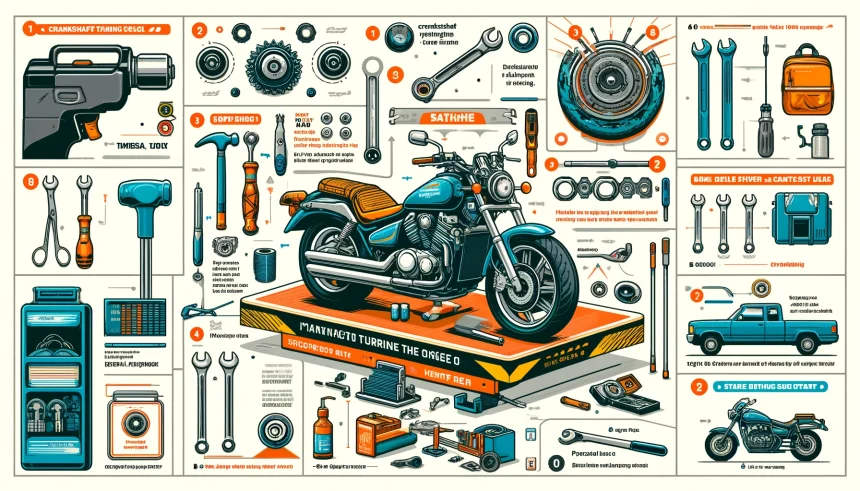Introduction: How to Turn Engine Manually on a VStar 1600
The Yamaha VStar 1600 is a popular cruiser with a robust engine, and while it’s usually low-maintenance, there are times when manually turning the engine is necessary. Here is a guide explaining why you might need to turn the engine manually, what tools you need, and how you can do so safely and efficiently.
Why Turn the Engine Manually on a VStar 1600?
Check cylinder compression, adjust valves, and adjust timing by manually turning the engine. This will aid in troubleshooting, routine checks, and maintenance tasks. By doing this, you can examine the engine more closely without running it under power, which can assist you in diagnosing any potential problems.
Tools Needed to Turn the Engine Manually
Before you begin, gather the following tools:
- Socket Wrench Set – This is necessary for removing bolts and accessing engine components.
- Breaker Bar – To gain the leverage needed to turn the engine manually.
- Crankshaft Turning Tool – Specifically designed to connect with the crankshaft for manual rotation.
- Torque Wrench – To ensure bolts are tightened to the correct specifications.
- Safety Gear – Gloves, safety glasses, and sturdy clothing for personal safety.
Important Safety Precautions
- Disconnect the Battery – Always disconnect the battery to avoid any accidental starts.
- Work in a Well-Ventilated Area – If indoors, ensure the area has proper ventilation.
- Wear Safety Gear – Protect your hands, eyes, and other exposed skin.
- Follow the Owner’s Manual – The VStar 1600 manual guides accessing and handling internal components.
Step-by-Step Guide to Turning the Engine Manually on a VStar 1600
Prepare the Work Area
Choose a stable, well-lit area with enough space to maneuver around the motorcycle. Set up the tools within easy reach and ensure the bike is stable on its stand.
Remove the Spark Plugs
Removing the spark plugs reduces compression in the engine, making it easier to turn manually. Use the correct socket to unscrew and gently remove the plugs from each cylinder.
Locate the Crankshaft Bolt
On the VStar 1600, the crankshaft bolt is generally located near the front of the engine, beneath the cover. You may need to remove some panels to access this area.
Attach the Crankshaft Turning Tool
Once the crankshaft bolt is accessible, attach the crankshaft turning tool. Ensure it fits snugly to avoid slippage during the process.
Use the Breaker Bar to Turn the Engine
With the crankshaft turning tool in place, attach the breaker bar for added leverage. Slowly turn the bar clockwise. You may feel resistance; move slowly and avoid forcing it to prevent damage to internal components.
Complete the Rotation and Check for Issues
Rotate the engine fully to your chosen point or as required. Pay attention to irregular resistance or sounds, which could indicate internal issues.
Reassemble and Test
Remove the breaker bar and turning tool once you manually turn the engine. Replace the spark plugs and any panels you removed, then reconnect the battery and run a quick test to ensure everything is in place.
Common Mistakes to Avoid
- Forcing the Engine – Forcing a turn can cause damage.
- Skipping Battery Disconnection – This can be a safety hazard.
- Using the Wrong Tools – Always use the appropriate tools to avoid component damage.
Tips for Beginners
- Start with Small Rotations – If you’re new to this, avoid turning the engine too far in a single rotation.
- Consult the Manual – Familiarize yourself with the VStar 1600 manual for precise details.
- Seek Help if Unsure – Don’t hesitate to consult a professional if unsure about any steps.
Trending FAQs
Can I Turn the Engine Manually on a VStar 1600 Without Removing Spark Plugs?
While it’s technically possible, removing the spark plugs reduces engine compression, making manual turning much more manageable and smoother.
What Should I Do if the Engine Won’t Turn Manually?
Stop immediately if you encounter strong resistance or the engine won’t turn. This could indicate a seized motor or other mechanical issue; further forcing may cause damage. Consult a professional mechanic.
How Often Should I Manually Turn the Engine on My VStar 1600?
Manual turning isn’t typically necessary for routine maintenance but can be useful for diagnostics or specific adjustments like valve clearance checks. Generally, perform this only as needed.
Conclusion
Manually turning the engine on a VStar 1600 is valuable for diagnosing issues, performing adjustments, and gaining a better understanding of your bike’s mechanics. While it may seem intimidating, following the proper steps, using the right tools, and prioritizing safety can make the process straightforward and effective. Whether you’re troubleshooting, checking components, or preparing for a repair, knowing how to rotate the engine manually empowers you to maintain your motorcycle confidently. If you encounter difficulties or unfamiliar resistance, consult a professional to prevent potential damage. Happy riding and safe maintenance!





